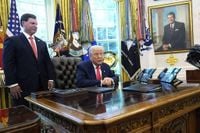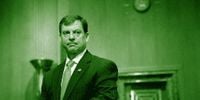In a move that has sent ripples through Washington and beyond, Frank Bisignano, the current commissioner of the Social Security Administration (SSA), has been named the first-ever chief executive officer (CEO) of the Internal Revenue Service (IRS). The announcement, made on October 6, 2025, by Treasury Secretary Scott Bessent, marks a dramatic and unprecedented consolidation of federal power, placing two of the government’s largest and most complex agencies under the stewardship of a single leader. As reported by Accounting Today, Axios, and the Associated Press, this appointment comes at a time of significant upheaval for both agencies and has sparked a mixture of hope, skepticism, and outright protest among policymakers, advocacy groups, and the public.
Bisignano’s new role is not just symbolic. He will oversee all day-to-day operations of the IRS while continuing his tenure as SSA commissioner, effectively juggling two of the most critical—and scrutinized—public-facing agencies. According to the Treasury Department’s statement, Bisignano will report directly to Secretary Bessent, who remains acting IRS commissioner following the abrupt removal of former commissioner Billy Long in August 2025. This arrangement, as The Wall Street Journal noted, allows the administration to quickly install a Trump appointee at the IRS without the traditional Senate confirmation process—a procedural shortcut that has not gone unnoticed by critics on Capitol Hill.
For Bisignano, the appointment is the latest chapter in a career defined by high-stakes leadership. Before entering public service, he was chairman and CEO of Fiserv, a major financial services and payment technology company, where he orchestrated the high-profile merger with First Data in 2019. His resume also includes stints as co-chief operating officer and CEO of mortgage banking at JPMorgan Chase, and as chief administrative officer and CEO of global transaction services at Citigroup. As Bessent put it in a press release, “Frank is a businessman with an exceptional track record of driving growth and efficiency in the private and now public sector.”
This private sector pedigree is precisely why Bessent tapped Bisignano for the dual role. According to Axios, the Treasury Secretary emphasized the shared technological and customer service goals of the IRS and SSA, arguing that Bisignano’s leadership could foster greater synergy and innovation between the two agencies. “Under his leadership at the SSA, he has already made important and substantial progress,” Bessent said, adding that Bisignano’s expertise would help the IRS sharpen its focus on collections, privacy, and customer service “to deliver better outcomes for hardworking Americans.”
But not everyone is convinced that this experiment in federal management will go smoothly. The appointment of a single executive to oversee both the IRS and SSA—two agencies with overlapping but distinct missions—has raised alarms among advocacy groups, policy experts, and some lawmakers. Kathleen Romig, director of Social Security and Disability Policy at the Center on Budget and Policy Priorities, questioned the wisdom of bypassing Senate confirmation for such a consequential appointment. “If the Trump Admin asked for the Senate’s advice & consent, would they really want the same person running the government’s biggest program AND overseeing the implementation of the extraordinarily complex new tax law?” Romig wrote on social media. She added, “This unprecedented arrangement cries out for meaningful oversight to ensure that each agency adequately serves the public, conflicts of interest are resolved, and our most sensitive data are protected.”
Concerns about divided attention and potential conflicts of interest are not merely academic. As AP and USA Today report, labor and retiree groups have already sued the SSA earlier this year over the agency’s decision to allow the Department of Government Efficiency access to Americans’ sensitive data. Although a divided appeals panel recently permitted this data sharing, the episode underscores the delicate balance required when one leader is responsible for agencies handling vast amounts of personal information. Mike Kaercher, deputy director of the Tax Law Center at NYU School of Law, warned, “Putting the same person in charge of both the IRS and SSA creates a conflict of interest when SSA wants access to legally protected taxpayer data.”
Senior and retiree advocacy groups have also voiced fears that Bisignano’s dual role could leave a leadership vacuum at the SSA, potentially undermining retirement security for millions of Americans. Nancy Altman, president of Social Security Works, was blunt: “Bisignano’s divided attention will create a bottleneck that makes the inevitable problems that arise even harder to correct. Never in Social Security’s 90-year history has a commissioner held a second job. Bisignano’s new role will leave a leadership vacuum at the top of the agency, especially since the Republican Senate hasn’t even confirmed a deputy commissioner.”
The context for these anxieties is a period of extraordinary instability at the IRS. Since January 2025, the agency has cycled through seven commissioners and acting commissioners, a level of turnover that has left staff morale battered and the agency’s strategic direction in flux. The White House has pushed for sweeping organizational reforms and staffing cuts at both the IRS and SSA, moves that have strained the agencies’ ability to deliver timely and accurate services. Many Americans—especially seniors—have found it increasingly difficult to resolve tax and Social Security issues, with backlogs and processing delays becoming commonplace.
Against this backdrop, Bisignano’s appointment is being framed by the administration as a bid to bring stability and private sector discipline to federal bureaucracy. The new CEO position at the IRS represents a shift from the agency’s historic commissioner-led structure to a model inspired by corporate governance. The hope, as articulated by Bessent, is that integrating customer service platforms, streamlining case management, and sharing best practices between the IRS and SSA will yield tangible improvements for the public.
Yet the path forward is anything but certain. Bisignano’s immediate priorities will include stabilizing staff morale, restoring public confidence in both agencies, and spearheading long-overdue technological upgrades. The IRS, in particular, faces pressure to modernize its data security protocols and embrace digital transformation, while the SSA must continue to deliver on its core mission of supporting retirees and vulnerable Americans. All the while, Bisignano will need to navigate the ever-present scrutiny of Congress, watchdog groups, and a skeptical public.
Adding to the complexity is the political backdrop. The Trump administration’s decision to bypass Senate confirmation for such a high-profile appointment has drawn criticism from those who see it as an end run around established norms of oversight and accountability. At the same time, some on the right have welcomed the move as a necessary step to implement the administration’s vision for the IRS, which emphasizes upgraded technology and a retreat from the heavier enforcement initiatives started under President Biden.
For his part, Bisignano has pointed to his history of “overseeing multiple mission-critical organizations at the same time” as evidence that he is up to the challenge. Whether this bold experiment in federal leadership will deliver the promised results—or become a cautionary tale—remains to be seen. In the coming months, all eyes will be on Bisignano as he attempts to bridge bureaucratic divides and deliver for millions of Americans who depend on the IRS and SSA every day.
The stakes could hardly be higher: the success or failure of this dual leadership model may well shape the future of federal service delivery for years to come.






